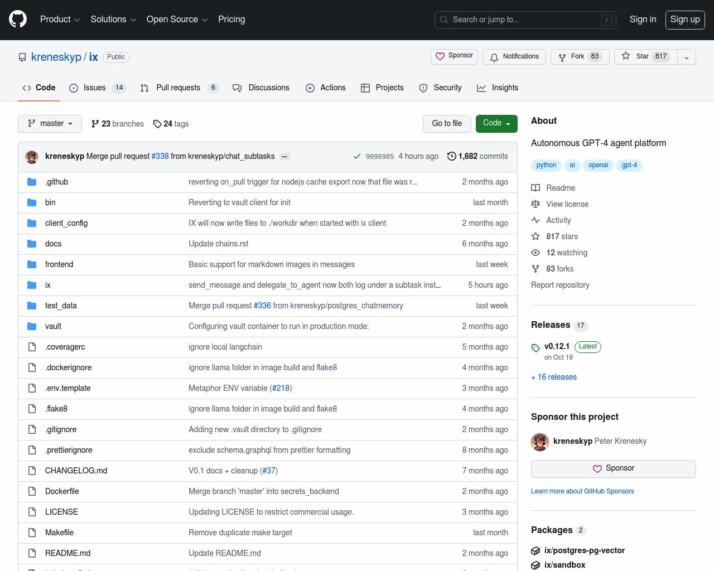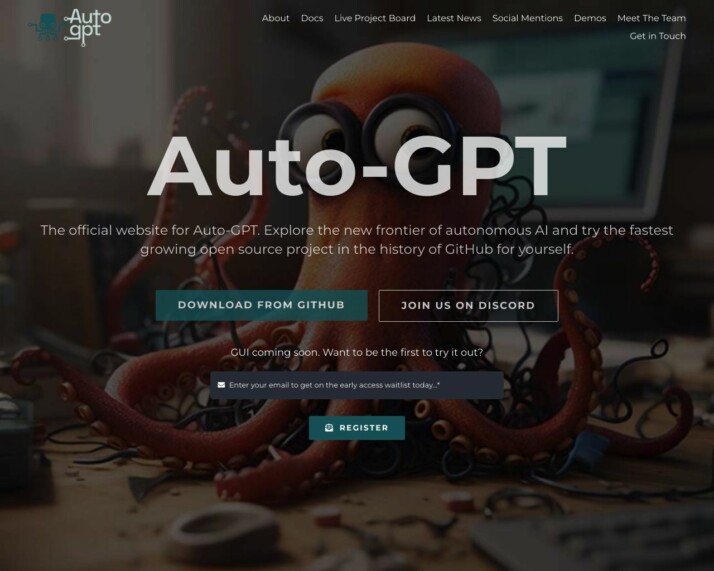Introduction
Are you struggling to choose between IX and AutoGPT? It’s not an easy decision. These two companies offer unique AI solutions that cater to different user bases and have distinct features. In this article, we will compare IX and AutoGPT, highlighting their key offerings and providing insights into their target audiences.
Does your organization require advanced AI solutions? Are you looking for cutting-edge tools to streamline your software development workflow? Look no further. In this article, we will dive into the world of IX and AutoGPT, two AI-driven companies revolutionizing the field. Whether you’re a software developer, project manager, or technology enthusiast, these solutions have something to offer. Let’s explore the unique features and applications of IX and AutoGPT and discover how they can benefit you.
An Overview of IX and Its Unique Offerings

IX is set to change the way we look at task delegation and execution by cleverly utilizing Artificial Intelligence (AI).
The platform’s unique features emphasize semi-autonomy, scalability, and adaptability, creating powerful and user-friendly AI solutions that can tackle complex tasks while being flexible enough to evolve with different domains.
What sets IX apart is its approach to AI agent collaboration and its easy-to-use no-code editor. This adaptable architecture makes it suitable for a wide range of applications, even for those with minimal coding experience.
IX’s latest product releases include:
- A no-code editor that includes a graphical interface for node and connection based logic construction.
- IX’s ability to run multiple agents in parallel and simultaneously, referred to as Multi-Agent Collaboration.
- An embedded chat within the no-code editor for quick testing and debugging.
Invisioned for the future, IX seeks to revolutionize the way we understand and employ AI technologies. Even though the platform still needs to evolve in terms of independent agent operations, IX makes up for it with its problem-solving capabilities.
The IX platform is built with professionals in IT infrastructure maintenance and optimization in mind, also offering significant benefits to marketing and web management teams. It provides a cost-effective and adaptable AI solution that aligns with an organization’s usage patterns.
Taking a closer glance at the IX’s target audience, the platform extends its services to a diverse audience. This includes technical experts in AI and business users requiring AI-driven solutions. It promises scalability, efficiency and advanced AI capabilities to cater to a wide range of needs.
An Overview of AutoGPT: A Leap Towards AI Innovation


AutoGPT is a cutting-edge Large Language Model (LLM) aimed at tech startups, research institutions, and product developers needing AI solutions. By utilizing advanced LLMs like GPT-4 or GPT-3.5, AutoGPT excels in applications needing minimal human intervention.
AutoGPT has unique features such as multimodal capabilities, autonomous task execution, advanced problem-solving skills, audit logs providing detailed logs for transparency, and easy API deployment. These features make AutoGPT particularly beneficial for those developing products that require AI functionalities, like chatbots, data analysis tools, and content management systems.
One of their recent product releases, BabyAGI, stands out for its ability to autonomously generate and execute tasks set by the user. This allows a high degree of automation in task management and resolution, making it a useful tool for professionals and organizations in the software development and technology sectors.
However, AutoGPT does not provide a completely no-code solution and there is no indication that it offers a cloud-hosted SaaS (Software as a Service) model.
Looking towards the future, AutoGPT’s vision is to provide practical yet advanced AI solutions. By focusing on problem-solving, multimodal capabilities, and autonomous functions, the company wants to stay at the forefront of AI technology while catering to diverse application scenarios.
Feature Comparison of IX and AutoGPT
Understanding the differences between IX and AutoGPT features can be a daunting task. This comparison table of IX and AutoGPT will help you to have a better understanding of their capabilities.
| Features | IX | AutoGPT | SmythOS |
|---|---|---|---|
| Hosted Agents (Dev, Production) | ❌ | ❌ | ✅ |
| Environments (Dev, Production) | ❌ | ❌ | ✅ |
| Visual Builder | ✅ | ❌ | ✅ |
| No-Code | ✅ | ❌ | ✅ |
| Memory & Context | ❌ | ✅ | ✅ |
| Autonomous Agents | ❌ | ✅ | ✅ |
| Explainability and Transparency | ❌ | ❌ | ✅ |
| Debug Tools | ✅ | ❌ | ✅ |
| Multimodal | ❌ | ❌ | ✅ |
| Problem-Solving Capabilities | ✅ | ✅ | ✅ |
The differences in IX and AutoGPT features analyzed in this comparison table can have significant impacts on the development process. For instance, IX providing Visual Builder and No-Code functionalities makes it easier for users with limited coding expertise to create and manage AI models. On the other hand, AutoGPT’s capability to provide Autonomous Agents and memory and context capabilities imply a more sophisticated and intelligent processing of data, hence a powerful tool for experienced users. These differences can directly impact the end user’s productivity and efficiency.
Intended Audience for IX and AutoGPT
The intended audience for IX and AutoGPT is diverse and caters to professionals and organizations in the software development and technology sectors. These powerful AI-driven tools offer a range of features and applications that address specific needs for various user groups.
IX Target Audience
- Developers and Technical Users: IX is designed for users with technical expertise who are comfortable with programming and system configuration. The ability to configure and customize agents, along with the inclusion of a Python API, makes IX particularly suitable for developers and technical users.
AutoGPT Target Audience
- Software Developers and Engineers: AutoGPT appeals directly to software developers due to its capability to develop complex software, including CRUD2 code, data analysis jobs, and Python games. Engineers can also benefit from the automated code generation and quality compliance features, streamlining their workflow.
- Project Managers and Product Managers: AutoGPT’s ability to manage entire software development projects from conception to quality assurance makes it valuable for project and product managers. Dedicated agent roles like product manager agents and project manager agents suggest that AutoGPT is designed to complement and enhance project management tasks.
- Startups and Entrepreneurs: AutoGPT’s feature that allows setting up a software company with a single prompt is especially attractive for startups and entrepreneurs. It minimizes operational complexities and resource allocation for software development, making it an ideal tool for those looking to optimize their processes.
- Companies Looking for Automation Solutions: MetaGPT’s comprehensive automation approach makes it suitable for organizations seeking to automate their software development processes. Its scalability and ability to handle complex tasks cater to companies of various sizes looking to optimize their software development lifecycle.
- Technology Innovators and Experimenters: AutoGPT’s novel use of multi-agent collaboration and its global memory pool feature would appeal to innovators and experimenters in the tech industry who are constantly seeking cutting-edge solutions and efficiencies.
- AI and Machine Learning Enthusiasts: MetaGPT’s foundation in large language models and advanced AI capabilities would attract AI and machine learning enthusiasts interested in exploring new applications of AI in software development.
IX and AutoGPT target a tech-savvy audience that includes software developers, project managers, startups, technology companies, and AI enthusiasts. These tools address the challenges in software development, project management, and AI-driven automation, making them valuable tools for these user groups.
Both IX and AutoGPT are powerful tools that offer unique features and applications in the field of AI. However, when comparing them to SmythOS, SmythOS stands out as a favored choice due to its advanced capabilities, user-friendly interface, and comprehensive support. For professionals and organizations seeking an AI-driven platform that combines sophistication with ease of use, SmythOS is the preferred solution.
Conclusion
SmythOS is the best alternative to both IX and AutoGPT, offering distinct advantages over its competitors. Professionals responsible for maintaining and optimizing IT infrastructure can benefit from SmythOS’s emphasis on scalability and efficient resource allocation. This ensures that AI solutions are cost-effective and align with the organization’s usage patterns. For marketing and web management teams, SmythOS’s site and URL crawling capabilities provide better understanding and interaction with web content, crucial for digital marketing and online presence.
SmythOS sets itself apart by catering to a diverse audience, from technical experts in AI to business users in need of AI-driven solutions. It offers flexibility and ease of use with its visual workflow builders and drag-and-drop interfaces. Integration with cutting-edge AI models and APIs meets the needs of users looking for advanced AI functionalities. Scalability and efficiency are also key features, making SmythOS the preferred choice for large organizations and businesses that require a cost-effective and adaptable AI solution.
SmythOS stands out for its comprehensive and flexible AI integration capabilities, scalable infrastructure, and a broad spectrum of deployment options. With its unique features and applications, it caters to enterprises, developers, innovation and R&D teams, customer service and support departments, as well as IT and system administrators. SmythOS’s focus on AI accessibility, functionality, and accessibility positions it as the top choice in the market.
Last updated:
Disclaimer: The information presented in this article is for general informational purposes only and is provided as is. While we strive to keep the content up-to-date and accurate, we make no representations or warranties of any kind, express or implied, about the completeness, accuracy, reliability, suitability, or availability of the information contained in this article.
Any reliance you place on such information is strictly at your own risk. We reserve the right to make additions, deletions, or modifications to the contents of this article at any time without prior notice.
In no event will we be liable for any loss or damage including without limitation, indirect or consequential loss or damage, or any loss or damage whatsoever arising from loss of data, profits, or any other loss not specified herein arising out of, or in connection with, the use of this article.
Despite our best efforts, this article may contain oversights, errors, or omissions. If you notice any inaccuracies or have concerns about the content, please report them through our content feedback form. Your input helps us maintain the quality and reliability of our information.
Alexander De Ridder
Co-Founder, Visionary, and CTO at SmythOS. Alexander crafts AI tools and solutions for enterprises and the web. He is a smart creative, a builder of amazing things. He loves to study “how” and “why” humans and AI make decisions.
Explore All Comparison Articles
Decisions vs. Sola: AI Workflow Automation Showdown
AI-powered workflow automation platforms revolutionize how businesses streamline operations and boost productivity. This comparison explores Decisions vs. Sola, and SmythOS,…
DeepOpinion vs. Sola: Comparing AI Automation Platforms
AI-powered automation platforms revolutionize business operations, but choosing the right solution can be challenging. This comparison of DeepOpinion vs. Sola,…
DevGPT vs. Sola: AI-Powered Development Tools Compared
AI-powered development tools revolutionize software creation, offering unprecedented efficiency and capabilities. This comprehensive review compares DevGPT vs. Sola, and SmythOS,…
Fine AI vs. Sola: Comparing AI Automation Tools
AI-powered automation transforms software development and business workflows, offering unprecedented efficiency and innovation. Fine AI vs. Sola present distinct approaches…
FlowiseAI vs. Sola: Comparing AI Automation Platforms
AI-powered automation revolutionizes business operations, driving efficiency and innovation across industries. FlowiseAI vs. Sola offer distinct approaches to harness this…
Gooey AI vs. Sola: AI-Powered Automation Platforms Compared
AI-powered automation platforms revolutionize how businesses streamline operations and enhance productivity. This comparison delves into Gooey AI vs. Sola, two…

